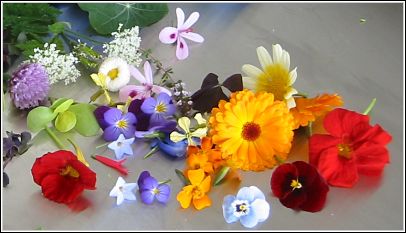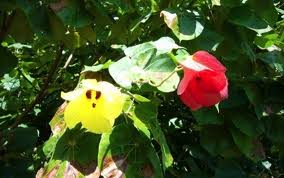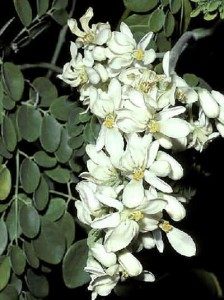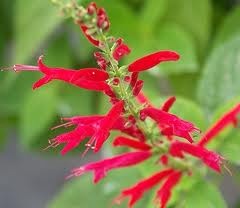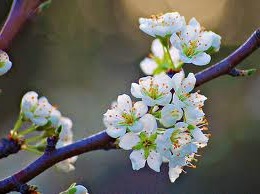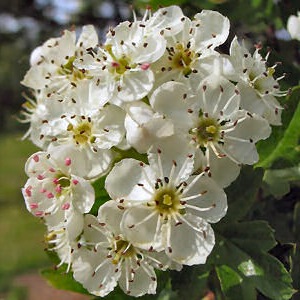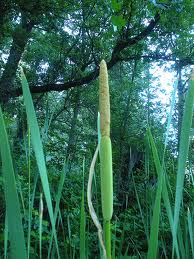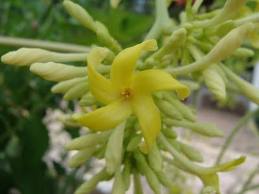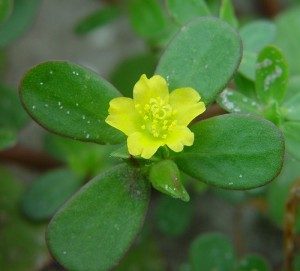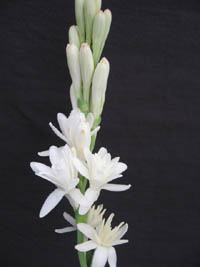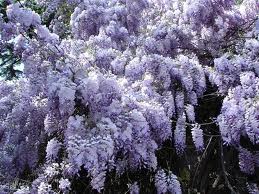Mahoe, Moringa, Pineapple Sage, Plum, Hawthorn, Cattail, Papaya, Purslane, Tuberose, Wisteria
One of the more fascinating flowers found in warm climates is that of the Mahoe, or the Sea Hibiscus. In the morning the blossom is yellow but by late afternoon it is red. The working theory is the shrub changes color to appeal to two different groups of pollinators. If one doesn’t get it in the morning, one might in the afternoon. The change in color also increases the amount of antioxidants. It also helps that almost the entire shrub is edible some way. The blossoms, yellow or red, can be eaten raw or cooked. Their flavor is mild. Incidentally, the Portia Tree, aka Seaside Mahoe, can be used the same way, flowerwise. Here’s an article on it.
I think besides an edible flower nearly everything else is also edible on our next species, the Moringa Tree. It is difficult to overstate the value of the tree. If a panel of experts were to design a nutritional, easy to grow, life-saving species it would be the Moringa. Indeed, it is being planted in many places around the world to not only fight hunger but malnutrition as well, ’cause they ain’t necessarily the same thing. I planted one on my property several years ago and it begate itself. Here in subtropical Florida the tree easily grows 10 feet a year. I coppice it every season, and feel he-man in the process because the tree is extremely brittle and one can break a three-inch branch easily by hand. I should do a video of that some year because it is rather amazing. The flowers are eaten cooked, usually boiled, and taste like mushrooms. To read about the Moringa click here.
Our next edible flower comes with a warning. Don’t eat its similar looking relative. How can you tell them apart? The one you want smells of pineapple, which is why it is called the Pineapple Sage, Salvia elegans. Sometimes it is also called the Tangerine sage. The point is crush a leaf and you will smell pineapple or tangerine. The one you don’t want is Salvia coccinea, also called the Scarlet Sage, the Texas Sage and the Hummingbird Sage. Crush its leaf and it smells grassy or slightly sage-like. Flowers of the Pineapple Sage, which taste like a hint of pineapple, are quite edible. However, even a quarter-inch square portion of a Salvia coccinea blossom will give you a big stomach ache and make you more than mildly ill. It’s not go-to-the-emergency-room ill but close to it. I know this from personal experience because once, for lack of a better word, I titrated the S. coccinea for potential edible use. It quickly let me know it is definitely is not an edible, raw at least. After my experience I had no interest in seeing if S. coccinea had any uses cooked.
Read this next entry as carefully as the last: You can eat some plum or peach blossoms, a few, a half dozen, but not a lot. Why? Because they have a chemical which when it goes through your tummy tum tum produces cyanide. A little cyanide we can tolerated, a lot will make you ill. Too much and you are deceased though admittedly it would take a lot of plum flowers to do that. Plum and peach flowers are a trail side nibble, a sprinkle in salads or on a dessert. Sparingly is the key. They are sweet, taste like nectar. Which ones? As far as I know any plum that produces plums and any peach that produces a peach that is edible. It should hold true for cherry blossoms as well as they are in the genus Prunus as well but I really don’t know. I would avoid the Laurel Cherry as it does not produce edible cherries. To read about Chickasaw Plums click here.
When I was growing up I lived on a dirt road out in the country. Across the road, kitty-corner, where two pastures met, was a Hawthorn tree. It was old and large and had two-inch thorns in grand profusion. It was also ladened every year with several families of birds because few predators would brave the thorns. As to which Hawthorn tree it was is anybody’s guess, even for a Hawthorn expert. It is one of those genus in which there may be a 100 species or a thousand. It is supposedly a professional joke in the botanical world to send a known Hawthorn to some one rather new and ask them to identify it to which the often reply is it must be a new species. Long ago someone discovered that very young Hawthorn leaves and blossoms in the spring could be eaten together right off the tree, thus the “Bread and Cheese tree” was born. Young leaves can be added to salads or nibble on. The blossoms, which have a peculiar taste, can be added to salads, desserts and drinks. Interestingly old leaves and fruit (minus seeds) are a natural beta blocker for high blood pressure. Two teaspoons of either or mixed ground up in a cup of hot water morning and night is the herbalist’s usual prescription. Read about Hawthorns.
You many not think of a cattail as having a blossom but it does and before it matures it is edible. In fact, both the male part of the flower and the female part of the flower are edible. Later when the male part produces pollen that’s edible as well. When the female parts turn brown it’s way past edible. The male part is the spike on top, the female part the wider portion below the spike. When both are green they can be boiled. The rest of the plant has edibles as well and is a well-known staple of the forager. The cattail rhizome is full of starch. In fact, no plants produces more edible starch per acre than the cattail. Read about them.
This won’t make much sense to those who live where there is a winter but the first time I climbed Turtle Mound — not a great feat as it is only 80 feet high — I was surprised to see papaya’s growing on top. Turtle Mound is a midden, an ancient trash heap made mostly of millions of oyster shells dumped there by ancient natives. It’s been more than three decades since my first visit and the papayas are still there, self-seeding as papayas do. A native of Mexico they are naturalized in warm areas of the world. Papaya blossoms, like very young leaves, are edible cooked, which is usually by boiling. Actually cooking the yellow flowers is a lot easier than pollinating them because there are female blossoms, male blossom, and male/female blossoms, kinda you, me and us. You have to move pollinating material around correctly or you don’t get fruit (also edible.) To read more about papayas click here.
It was something of a debate, to make this entry or not. After all, purslane is one of the most esteemed wild and cultivated edibles in the world (except oddly the United States.) It is used as a salad ingredient, a vegetable, a soup thickener, a flour, and a pickle. And yes, the flowers are edible but they are only open for a day. And when I say purslane I mean Portulaca oleracea, the kind with yellow blossoms only. Yes, I know there are commercial cultivars of multiple colored blossoms and they might look wonderful in a salad. But, I don’t know if they are edible. The Moss Rose/Rose Moss, another wild Purslane, Portulaca pilosa, is in my estimate not edible. So I stick with the original, common purslane with the yellow blossom. They are edible raw and cooked. Incidentally, the tiny pink blossoms of the sea purslane, Sesuvium portulacastrum, is also edible raw or cooked. Click here to read more.
Tuberose has been put to a lot of uses. The Hawaiians used it to make leis. In Victorian times it was the funeral flower of choice. Then it spent a long time helping perfumes smell the way they do. Now it can be found as a food in five star hotels, well… at least those in the Orient. Botanically it is Polianthes tuberosa and might be a native of Mexico.The flowers open from the bottom of the flower spike up and can last a couple of weeks if you remove the blossoms and eat them. The Aztec so liked the flower their used its oil to flavor their chocolate. They are eaten cooked and are traditionally added to vegetable soups. They are also used to flavor some soy sauces
Wisteria is a nibble of spring, here for a few weeks and then gone. The blossoms of various species are edible cooked — some raw — but they are usually blanched in boiling water, strained, and mixed into salads or the deep fried. The rest of the plant is toxic per se. In fact, as little as two raw seeds can kill a child. That is not uncommon for a member of the pea family which ranges from edible to toxic. See my full article on wisteria here. One of the most common of the 8 to 10 species of wisteria is Wisteria sinsensis, or the Chinese Wisteria. It’s a vigorous, fast grower that doesn’t need fertilizer and fixes nitrogen. In fact, abuse improves blossoming as does pruning. It can live at least 115 years (as of April 2011) and is consider an invasive species is some areas. It has naturalized from Maine to Florida and as far west as Arkansas. Not bad since its arrival in 1816. Another one commonly eaten wisteria is Wisteria floribunda from Japan, also escaped in the US.

